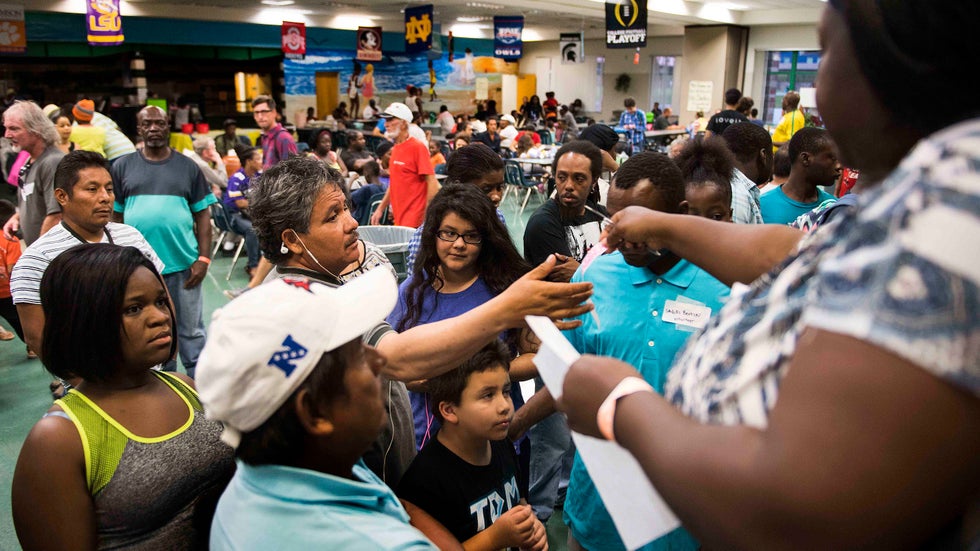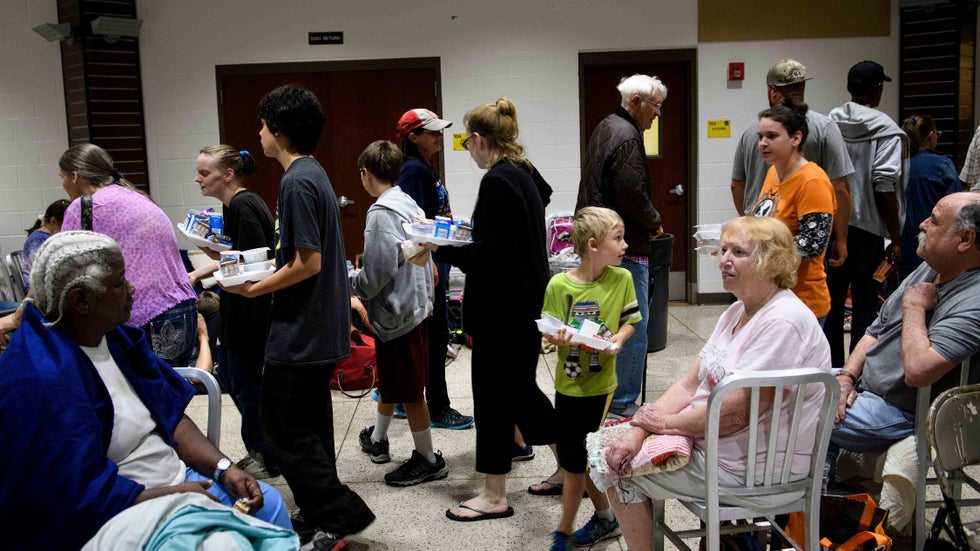Jan Wesner Childs
As two tropical storms have the upper Gulf Coast in their crosshairs this week, those in the path could be faced with a tough decision: Go to a shelter and risk the chance of being exposed to coronavirus, or stay home and take their chances that the weather will spare them.
In many major hurricane-prone areas, officials worry that people won't heed evacuation warnings.
"COVID adds another layer ... so we have a fear that people will hesitate or not evacuate because they’re more afraid of COVID than they are of a major hurricane," Collin Arnold, director of homeland security and emergency preparedness in New Orleans, told weather.com in a recent interview. "You have to realize that if a mandatory evacuation of a major American city is called, it's because the threat and magnitude of that major hurricane is greater than the spread of the pandemic. That’s kind of where we’re at."
A few communities in Louisiana issued evacuation orders over the weekend ahead of potential impacts from tropical storms Marco and Laura, but the state is hoping to avoid opening large group shelters.
(MORE: Track Laura and Marco)
Shelter turnout has been low in some states that have already been hit or threatened by storms and hurricanes this year. Officials up and down the Gulf Coast say residents should do their best to avoid public shelters and instead stay in a hotel, or with family and friends.
But, for some, sheltering is the only option.
"Sheltering is not going to be an ideal thing this year for anybody but it is going to be a way for people to stay safe," said Rupert Lacy, emergency management director for Harrison County, Mississippi.
American Red Cross spokesperson Greta Gustafson said the organization is taking extra precautions to help evacuees feel safer.
"We do completely understand that concern which is why we’re doing everything we can to mitigate any sort of risk," Gustafson said. "When you come to a shelter, what you’re first going to see is a volunteer who is standing outside, who's taking temperatures and making sure to do that quick health screening, and making sure that everyone has a mask before they even enter a shelter."
Those who evacuated in the wake of Hurricane Isaias earlier this month were handed masks at some shelter entrances if they didn't already have one. Temperatures were taken, too.
The same was true for those who fled flooding from Hurricane Hanna in South Texas in July. But volunteers to help were in short supply due to the coronavirus pandemic.
And ahead of Hawaii's close call with Hurricane Douglas, officials warned residents that shelter space would be limited due to the need for social distancing.
(MORE: Hurricane Hanna Shelters Overcame Challenges of Social Distancing, Lack of Volunteers)
The American Meteorological Society and several state agencies have issued recommendations advising people who are told to evacuate that they will be safer in shelters than in severe weather. The U.S. Centers for Disease Control and Prevention has issued guidelines to help evacuees stay safe in shelters. The tips advise people to bring their own hand sanitizer and face coverings, maintain social distancing and avoid touching high-contact surfaces such as doorknobs.
The Federal Emergency Management Agency recently released operational guidance for state and local governments during the 2020 hurricane season.
Weather experts, health officials and emergency management agencies who have so far weighed in on the topic recommend that those who are told to evacuate for any type of severe weather do so, regardless of the pandemic.
"There’s not a whole hell of a lot of choices," Miami-Dade Director of Emergency Management Frank Rollason said. "As my daddy would say, you gotta ride the horse you got, and that’s what we’re going to do."
"We will be here and we will address it and we will have a plan and we will do our best to execute those plans as we always do. We’re just going to have to adapt," Rollason added. "We’re going to make plans for a contingency that we didn’t have to think about last year."
Or, really, ever.
Mark Bowen, emergency management director in Bay County, Florida, where Hurricane Michael made landfall in 2018, called planning for severe weather in the face of coronavirus "quite a new paradigm."
This hurricane season is expected to be more active than normal, and Tropical Storm Arthur kicked it off about two weeks early when it formed on May 17. More than a dozen other named storms have followed in the Atlantic since. While none of them caused any major impacts, each is an unsettling reminder that hurricane season and coronavirus are a complicated mix that requires completely new ways of doing things.
(MORE: Amid Coronavirus Pandemic, Nonprofits Responding to Hurricanes Face Volunteer, Funding Shortages)
Officials in Florida, for example, are considering using ride-sharing services rather than buses to transport people who need transportation out of evacuated areas.
 People who evacuated ahead of Hurricane Irma crowd around a Red Cross volunteer at a shelter at an elementary school in Tampa, Florida, on Sept. 9, 2017.
People who evacuated ahead of Hurricane Irma crowd around a Red Cross volunteer at a shelter at an elementary school in Tampa, Florida, on Sept. 9, 2017.In Charleston, South Carolina, neighboring counties might be called upon to open their shelters. Charleston County Emergency Management Director Jason Patno said his community has 75% fewer shelters than it did last year because of the need to social distance. All of the county's 412,000 residents live in some level of evacuation zone.
"If you have the means and the ability to evacuate, then you need to do so," Patno said. "We’ve always stated that’s the only way we can ensure your safety. But in this case, we have so few shelter spaces that we actually need to reserve those for our residents that just do not have the means or ability to evacuate outside of the threat zone."
Emergency management specialists are used to preparing for the worst. But the coronavirus pandemic, they say, is like the whole country being hit by a Category 5 hurricane at the same time. Resources are already spread thin, and neighboring counties and states may not be able to lend a hand like they normally would.
"If you got an Andrew hit that comes through a very populated area, we’re going to be stressed out, we’re going to be beyond our capability," Rollason said, referencing Hurricane Andrew, which devastated parts of South Florida in 1992.
(MORE: Why August Marks the Beginning of What Is Typically the Busiest Part of Hurricane Season)
Nearly 7 million people in Florida, Georgia and South Carolina were told to evacuate ahead of Hurricane Irma in 2017. Scores of others made the decision to leave on their own. Many went to hotels or to stay with family and friends, options that officials say are good choices if social distancing can be maintained.
Counties generally draw up severe weather plans based on the number of people who would need shelter in a worst-case scenario.
In Miami-Dade, for example, the numbers are calculated to give each person in a shelter 20 square feet of "personal space." But Rollason said that doesn't necessarily allow for six feet between them, as mandated by social distancing guidelines. So the county is looking at options to have more shelters available.
 People wait for breakfast as they and others seek safety in a shelter as Hurricane Michael approaches on Oct. 10, 2018, in Panama City, Florida. Officials worry about managing social distancing in shelters in the wake of the coronavirus pandemic.
People wait for breakfast as they and others seek safety in a shelter as Hurricane Michael approaches on Oct. 10, 2018, in Panama City, Florida. Officials worry about managing social distancing in shelters in the wake of the coronavirus pandemic."We will adapt to what we have to adapt to," he said. "We jam all the people in, we ride out the hurricane, we send them home, we separate."
In smaller municipalities like New Hanover County, North Carolina, a more pressing concern is the resiliency of employees who are already staffing emergency operations centers 24/7 in response to the coronavirus.
"Capacity's not an issue, it's longevity … that's certainly a concern for the health and mental well-being of our staff," said Steven Still, the county's director of emergency management.
Still and others also pointed out that no one can predict how the coronavirus pandemic will play out over the rest of the summer and into the early fall, which is the peak of hurricane season. Officials will have to adjust as they go.
Rollason asked his daughter, who has a young son, if she would evacuate in the event of a hurricane, even later in the season.
"She said 'You’re crazy, I’m not going to any shelter. I’m not going to (get) crammed in. People are still going to be sick,'" Rollason said.
"We’re preaching every day stay away, stay away, and now we’re going to tell them, 'Look, you’ve got to come to this place.'"
Bowen said the bottom line for those in the path of a hurricane remains the same: "If they’re told to evacuate, they need to heed that."
The Weather Company’s primary journalistic mission is to report on breaking weather news, the environment and the importance of science to our lives. This story does not necessarily represent the position of our parent company, IBM.
The Weather Company’s primary journalistic mission is to report on breaking weather news, the environment and the importance of science to our lives. This story does not necessarily represent the position of our parent company, IBM.

No comments:
Post a Comment